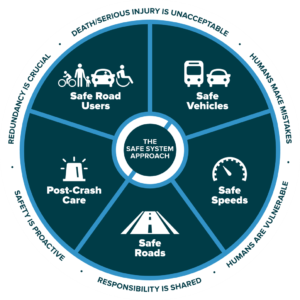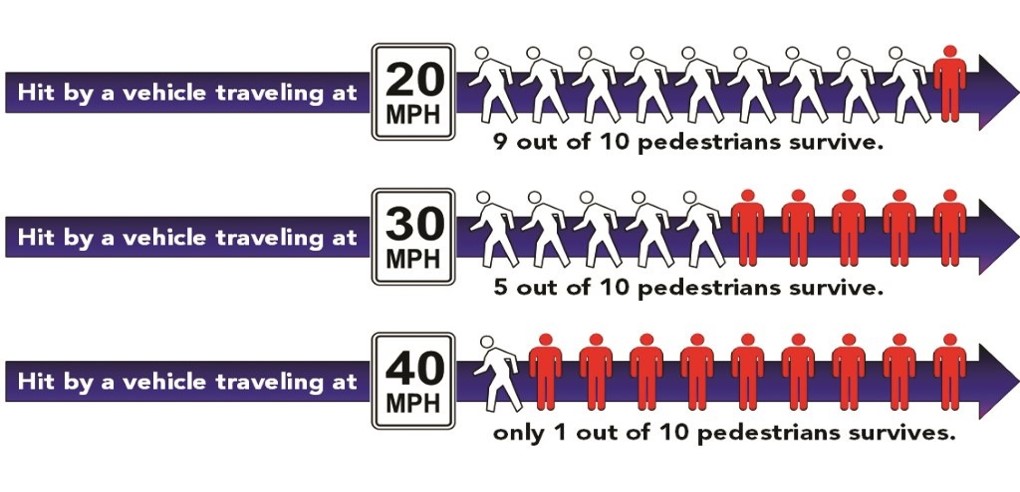Traffic safety
Fundamentals of a Safety First Approach
It’s rare to find a transportation agency or politician at any level of government that doesn’t identify safety as a top priority. Yet, roads continue to be designed and built with features that are known to be dangerous. It’s politically easy to support the principles of safe streets, but far more challenging to take the necessary steps to make it a reality. It’s tempting to treat traffic safety as an individual behavior problem in need of a catchy slogan or a clever marketing campaign. To avoid that pitfall, governments must do the courageous work of taking responsibility for the safety performance of their transportation systems. We shouldn’t fear honest and transparent dialogue about how a truly safety-first system would function, what it would cost to implement politically and financially, and what benefits and drawbacks would result.
 Putting safety first goes by multiple names: Safe System Approach, Vision Zero, Sustainable Safety. While there are nuanced differences, these terms share values and principles and are part of a new cross-disciplinary way of thinking about making streets safe. In the United States, the term “Safe System Approach” is emerging as a go-to way to describe systemic and data-driven traffic safety efforts, and has been embraced by the US Department of Transportation and other leading agencies. Whatever the label, these modern approaches to traffic safety are characterized by high-level public commitments from officials, data-led and equity-focused strategies, and proactive and contextually sensitive street design to craft a multi-layered systemic strategy. They require coordination among diverse sectors, including law enforcement, public health, and transportation. It’s a multi-faceted approach that requires strong leadership, robust and authentic public engagement, and collaboration across agencies, disciplines, and practices.
Putting safety first goes by multiple names: Safe System Approach, Vision Zero, Sustainable Safety. While there are nuanced differences, these terms share values and principles and are part of a new cross-disciplinary way of thinking about making streets safe. In the United States, the term “Safe System Approach” is emerging as a go-to way to describe systemic and data-driven traffic safety efforts, and has been embraced by the US Department of Transportation and other leading agencies. Whatever the label, these modern approaches to traffic safety are characterized by high-level public commitments from officials, data-led and equity-focused strategies, and proactive and contextually sensitive street design to craft a multi-layered systemic strategy. They require coordination among diverse sectors, including law enforcement, public health, and transportation. It’s a multi-faceted approach that requires strong leadership, robust and authentic public engagement, and collaboration across agencies, disciplines, and practices.
Fundamental Principles of a Safe System Approach
- Humans are imperfect, and traffic mistakes will happen
- Traffic crashes are inevitable, but deaths and severe injuries are preventable
- Safety should lead street design, and expect and be forgiving of human error
- The faster the speeds, the greater the danger. Crashes at speeds of more than 20 mph (30 kph) are exponentially more likely to cause death or severe injury
- Safety is proactive; use data-driven decision making to identify risks and prioritize the most dangerous situations
 (Credit: Vision Zero Network)
(Credit: Vision Zero Network)
There’s a lot to consider and a lot at stake. As with the climate crisis, it’s easy to feel overwhelmed by the traffic safety problem because it is systemic and cannot be solved by any one organization, government, or profession. For transportation professionals unsure of where to begin, a truly safety-first approach starts with a commitment to utilize one of the most powerful and fundamental tools of roadway design and policy: speed management.
Safe Roads, Safe Speeds
Put bluntly, speed kills. A safe system approach puts contextual speed management at the core of every street design project. If the operating speed of a roadway does not match the posted speed, then either the engineering or the policy has failed. Putting safety first means ending the use of 85th percentile and other dated methods for setting speed limits that normalize dangerous conditions. Instead, roadway designs should adopt more proactive and data-driven methods to prevent the most severe consequences of inevitable human mistakes.
Targeted education and equitable law enforcement are helpful, but shouldn’t be depended on to hide a failed design. In a safe system approach roadway design should always strive to be self-enforcing. Strong coordination between policy, community engagement, law enforcement, and design is a precondition for effective speed management. Just as simply changing posted speed limits without engineering changes is unlikely to change the way a street works, design changes without strong policy and vision backing them is unlikely to be welcomed by the community or result in system-wide implementation. Leadership is critical to empowering designers to match speeds to function.
There are many tools in a safe system approach. For transportation professionals, ensuring the right speeds on the right roads is the most direct path to a meaningful impact. Put another way, if a community aspires to apply a safe system approach, but isn’t being proactive about managing speeds, then it isn’t a safe system approach.
 ">
">Zach Vanderkooy
‘Dutch urbanism may seem like magic at first glance, but it’s the result of courageous (and replicable) choices made by human beings. Experience from the Netherlands has tremendous power to inspire and inform the creativity we need to build more resilient, safe, equitable and prosperous communities.’

